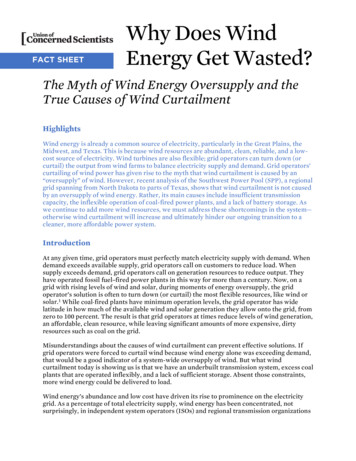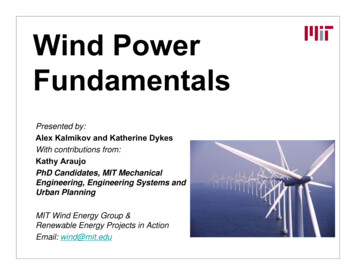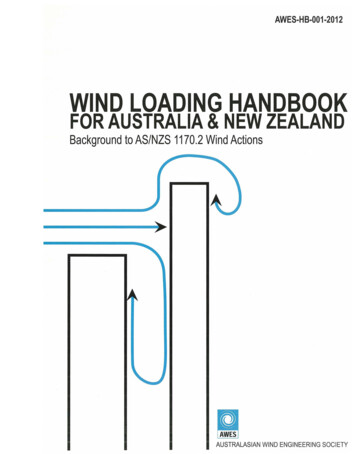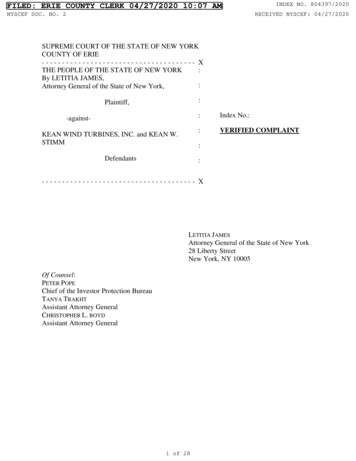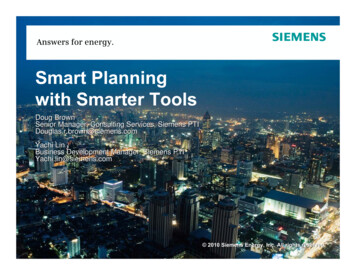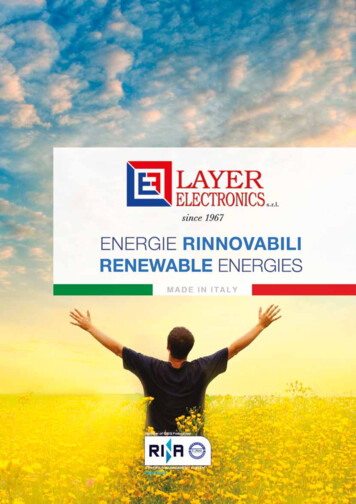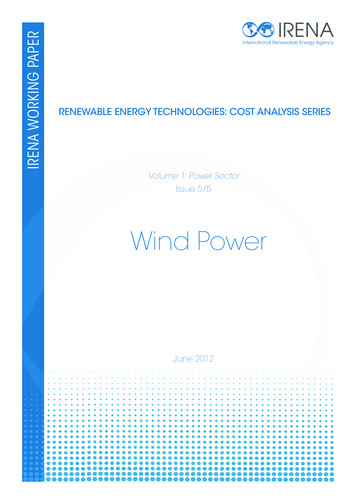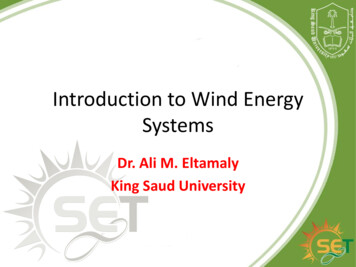
Transcription
Introduction to Wind EnergySystemsDr. Ali M. EltamalyKing Saud University
Agenda Historical Development of WT Current Status and Future Prospects of WindEnergy Types of Wind Turbine Generators (WT) Orientation of WT Sizes and Applications of WT Components of WT Wind Power Calculations
Historical Development Wind has been used by people for over 3000 years forgrinding grain, sailboats, and pumping water Windmills werean important part of life for many communities beginningaround 1200 BC. Wind was first used for electricity generation in the late 19thcentury. The Babylonian emperor Hammurabi planned to use wind power forhis ambitious irrigation project during seventeenth century B.C. The wind wheel of the Greek engineer Heron of Alexandria in the1st century AD is the earliest known instance of using a winddriven wheel to power a machine Wind-driven wheel was the prayer wheel, which was used inancient Tibet and China since the 4th century
By the 13th century, grain grinding mills were popularin most of Europe French adopted this technology by 1105 A.D. and theEnglish by 1191 A.DOld windmill.
The era of wind electric generators beganclose to 1900’s. The first modern wind turbine, specificallydesigned for electricity generation, was constructedin Denmark in 1890. The first utility-scale system was installed inRussia in 1931. A significant development in large-scalesystems was the 1250 kW turbine fabricated byPalmer C. Putman.
Built around a central postJune 19 – 20, 2007Wind Energy
Smith PutnamMachine1941Rutland, Vermont1.25 MW53 meters (largestturbine for 40 years)Structural steelLost blade in 1945
Mod-5B Horizontal axis windturbine.Darrieus wind turbine is vertical axiswind turbine.
Current status and future prospectsWind is the world’s fastest growing energy sourcetodayThe global wind power capacity increases at least 40%every year.For example, the European Union targets to meet 25 per centof their demand from renewable by 2012.Spain also celebrates in Nov. 10, 2010 when the wind energyresources contribute 53% of the total generation of theelectricity.Over 80 percent of the global installations are in Europe.Installed capacity may reach a level of 1.2 millionMW by 2020
The installed capacity from the wind worldwide.
Installed capacity in different regions in the world, 2010.
(a) SWAY 10MW.
Enercon E126, 7.5MW, 126 diameter
Top ten manufacturers of WTs, 2009.
Types of Wind Turbine Generators (WT)1. Horizontal Axis WTs (HAWTs)The HAWT configurations
Vertical Axis WTs (VAWTs)The VA-WTs Configurations
Orientation of WTTurbines can be categorized into two overarchingclasses based on the orientation of the rotorVertical AxisHorizontal Axis
Vertical Axis TurbinesAdvantages Omnidirectional– Accepts wind from any angle Components can be mounted at ground level– Ease of service– Lighter weight towers Can theoretically use less materials to capturethe same amount of windDisadvantages Rotors generally near ground where windpoorer Centrifugal force stresses blades &components Poor self-starting capabilities Requires support at top of turbine rotor Requires entire rotor to be removed toreplace bearings Overall poor performance and reliability/lessefficient Have never been commercially successful(large scale)WindspireSavonious
Horizontal Axis Wind Turbines Rotors are usually Up-windof tower Some machines havedown-wind rotors, butonly commerciallyavailable ones are smallturbines Proven, viable technology
Comparison between HA-WTs and VA-WTs.ItemsHA-WTsVA-WTsOutput powerWide rangeNarrow rangeStartingSelf startingNeed starting meansEfficiencyHigherLowerCostLowerHigherWind directionNeed redirected when theWind change its directionDoes not needs redirectedinto the wind directionGenerator and gear box At the top of the towerAt the ground levelMaintenanceEasyDifficult
Upwind and Dawnwind WT
Upwind turbines have the rotor facing the wind as shown inFig.1.11 (a). This technique has the following features: Avoids the wind shade that the tower causes which improve thepower quality of the generated voltage and reduces the spicks inpower when the blades move in front of the tower specially inconstant speed systems. Fewer fluctuations in the power output. Requires a rigid hub, which has to be away from the tower.Otherwise, if the blades are bending too far, they will hit the tower. This is the dominant design for most wind turbines in the MWrange
Downwind WT have the rotor on the flow-side as shown inFig.1.11 (b). It may be built without a yaw mechanism if the nacellehas a streamlined body that will make it follow the wind. Rotor can be more flexible: Blades can bend at high speeds,taking load off the tower. Allow for lighter build. Increased fluctuations in wind power, as blades are affected bythe tower shade. Only small wind turbines.
1.3.4Number of Rotor BladesInfluence of the number of blades on the rotor power coefficient(envelope) and the optimum tip-speed ratio.
shows one blade WT.
Sizes and ApplicationsSmall ( 10 kW) Homes Farms Remote Applications(e.g. water pumping,telecom sites, icemaking)Intermediate(10-250 kW) Village Power Hybrid Systems Distributed PowerLarge (660 kW - 2 MW) Central Station Wind Farms Distributed Power Community Wind
Large and Small Wind TurbinesLarge Turbines (600-2000 kW) Installed in “Windfarm” arrays totaling 1 - 100 MW 1,300/kWDesigned for low cost of energy (COE)Requires 6 m/s (13 mph) average wind speedValue of Energy: 0.02 - 0.06 per kWhSmall Turbines (0.3-100 kW) Installed in “rural residential” on-grid and off-gridapplications 2,500- 8,000/kWDesigned for reliability / low maintenanceRequires 4 m/s (9 mph) average wind speedValue of energy: 0.06 - 0.26 per kWh
Small Wind Turbines Blades: Fiber-reinforced plastics,fixed pitch, either twisted/tapered,or straight (pultruded) Generator: Direct-drivepermanent magnet alternator, nobrushes, 3-phase AC, variablespeed operation10 kW50 kW Designed for:– Simplicity, reliability– Few moving parts– Little regular maintenance required400 W900 W
Wind Turbine components
Yaw systemYaw drive: Upwind turbines face into the wind; the yaw drive is used to keepthe rotor facing into the wind as the wind direction changes. Downwindturbines don't require a yaw drive, the wind blows the rotor downwind.Yaw motor: Powers the yaw drive.
YAW MECHANISM It is used to turn the turbineagainst the wind.If the turbine is not perpendicularto the wind, then the powerflowing is lower.Almost all HAWT use forcedyawing, i.e they use electricmotors and gearbox.Wind turbine running with yawerror are running with hiherfatigue loads.
Yaw mechanism
1.3.5 Aerodynamics of Wind TurbinesImportant parameters of an airfoil12L CL a A V212D CD a A V2where CL and CD are the lift and drag coefficients respectively.
Airfoil ShapeJust like the wings of an airplane,wind turbine blades use the airfoilshape to create lift and maximizeefficiency.The Bernoulli Effect
Lift & Drag Forces The Lift Force isperpendicular to thedirection of motion.We want to make thisforce BIG. The Drag Force isparallel to the directionof motion. We want tomake this force small.α lowα medium 10 degreesα HighStall!!
Effect of angle of attack on airfoil lift
Pitch Control MechanismsKidWind Project www.kidwind.org
BRAKING MECHANISM Itessential for turbines to stopautomatically in case malfunction ofcomponents. Thus, it is necessary to have an over speedsafety system. There are two types of braking:1.aerodynamic braking system2.mechanical breaking system
1.Aerodynamic brakingsystem It consists of turning the rotor blades ortips about 900 about the longitudinalaxis.They are spring operated and thus workeven in case of power failure.They have a very gentle and secure wayof stop the rotor thus avoiding thedamage.They are extremely safe .
MECHANICAL BRAKING SYSEMthey act as back-up for othermechanism.
Control MechanismsIts purpose is to: Optimize aerodynamic efficiency, Keep the generator with its speed andtorque limits and rotor and tower withinstrength limits, Enable maintenance, and, Reduce noise.
Stalling (Losing power) Principle: Increased angle ofattack results in decreasing lift-to-drag ratio.The schematic representing the Stalling controlregulator.
Passive: Blades are at a fixed pitch that starts to stall whenthe wind speed is too high. Active: motor turns the blades towards stall when windspeeds are too high. Hybrid: Pitch can be adjusted manually to reflect site'sparticular wind regime. Disadvantages:1- Stalled blades cause large vibration and therefore noise.2- The aerodynamic power on the blades is limited. Suchslow aerodynamicpower regulation causes less power fluctuations than a fastpitch power regulation.3-lower efficiency at low wind speeds4- It needs startup means.
Pitch Control Principle: Decrease angle ofattack also results in decreasing lift-to-dragratio.The schematic representing the pitchcontrol regulator.
Always active control: Blades rotate outof the wind when wind speeds are toohigh.The advantages of this technique are: good power control, No need for startup means. It can be combined with emergencystop means.The main disadvantage of thistechnique is the extra complexity arisingfrom the pitch mechanism and thehigher power fluctuations at high windspeeds.
Furling Principle: Moving the axis out of thedirection of the wind decreases angle of attack andcross-sectionThe schematic representing the Furling control regulator.
Requires active pitch control: Pitch angle of theblades needs to be minimized first, otherwise thetorque on the rotor would be too big for furling. Active: Vertical furling (as diagram) withhyrdraulic, spring-loaded or electric motor driven. Passive: Horizontal furling with yaw.
Illustration of stall, active-stall and pitch effects.
GENERATOR Theyare a bit differentthan other turbines b'cozthey have to handlechanging mechanicaltorque. They usually producearound 690 V, 50 or 60 Hz,3 phase ac.
TowersLattice towerTubular steel towers,Guyed Pole TowerConcrete tower
Wind Power
1.Sitting of Wind Energy PlantsWind PowerThe power in the wind canbe defined as follows,where13Pw a A V2 a : Air density, kg/m3.A: Cross sectional area of wind parcel, m2.V: The wind speed, m/sec. Z V ( Z ) V ( Zg ) * Zg where Z : The height above the ground level, m.Zg : The height of where the wind speed is measured, m. : The exponent, which depends on the roughness of the groundsurface, its average value, is (1/7) [14].
Fig. 1.22 Actual WT output power with the wind speed.
Betz' LawBetz: law says that you can only convert less than 16/27 (or59%) of the kinetic energy in the wind to mechanical energyusing a wind turbine.
Tip-Speed RatioTip-speed ratio is the ratio of thespeed of the rotating blade tip tothe speed of the free streamwind.There is an optimum angle ofattack which creates the highestlift to drag ratio.Because angle of attack isdependant on wind speed, thereis an optimum tip-speed ratioTSR ΩRVWhere,Ω rotational speed in radians /secR Rotor RadiusV Wind “Free Stream” VelocityΩRR
Performance Over Range of Tip Speed Ratios Power Coefficient Varies with Tip Speed Ratio Characterized by Cp vs Tip Speed Ratio Curve
Betz LimitAll wind power cannot becaptured by rotor or airwould be completely stillbehind rotor and notallow more wind to passthrough.Theoretical limit of rotorefficiency is 59%Most modern wind turbinesare in the 35 – 45% range
Over-Speed Protection During High WindsUpward Furling: The rotor tiltsback during high windsAngle Governor: The rotor turns up and to one side
Rotor DesignR 2 PDC PD d g a VD3R 2E A s a VD3 T1. Radius of the rotor (R)2. Number of blades (B)3. Tip speed ratio of the rotor at the design point (λD)4. Design lift coefficient of the airfoil (CLD)5. Angle of attack of the airfoil lift (α)
Fig.1.23. Number of blades and design tip speed ratio
ExampleDesign the rotor for a WT develop 100 W at a wind speed of 7 m/s.NACA 4412 airfoil may be used for the rotor.Let us take the design power coefficient as 0.4 and the combined drive train andgenerator efficiency 0.9. Taking the air density as 1.224 kg/m3, from Equation (1.7),the rotor radius is:
Weibull Statisticsk u f u c c k 1 u k exp , c k 0, u 0, c 1 c 1.12 u 1.5 k 3.0 Weibull density function f(u) for scale parameter c 1.
ExampleThe Weibull parameters at a given site are c 6 m/s and k 1.8. Estimate thenumber of hours per year that the wind speed will be between 6.5 and 7.5 m/s.Estimate the number of hours per year that the wind speed is greater than or equalto 15 m/s. From Eq. (1.25), the probability that the wind is between 6.5 and 7.5 m/sis just f(7), which can be evaluated from Eq. (1.21) as:1.8 11.8 7 f 7 6 6 7 1.8 exp 0.0907 6 This means that the wind speed will be in this interval 9.07 % of the time, sothe number of hours per year with wind speeds in this interval would be;0.0907*8760 794 hr.From Eq. (1.24), the probability that the wind speed is greater than or equal to 15m/s is 15 1.8 P u 15 exp 0.0055 6 which represents0.0055*8760 48 h/year
Determining the Weibull Parameters 1.086 k u 2 1 1 2 / k uc 1 1 / k c 1.12u , 2 1.5 k 3.0 exp uc / c k exp u R / c kk Peave PeR exp u F / c kk u R / c uc / c NWT 2 c 2 1 2 1 u 2 1 k k 1 1 / k PL avPeave
Design of Wind Energy SystemData ofavailable WTsWeibullstatisticalanalysisHourly Windspeed data ofavailable sitesHourly loaddataEnergy balanceanalysisCost analysisOutput resultsSummarized block diagram of the analysis
StartReadInput number of sites, N1Input number of WTG, WTGRead all The data of WTGRead Load (e,d)Read Hourly Wind Speedand Frequency of EachSpeed for All SitesSubrotine #1Calculation of Weibull parametersSubrotine #2Calculation of Capacity FactorSubrotine #3Calculation of Energy BalanceSubrotine #4Calculation of ECFSubrotine #5Printing the resultsEndFlowchart of the main computer program.
Project Developmentelement of wind farm% of total costWind Turbines65Civil Works13Wind farm electrical infrastructure8Electrical network connection6Project development and management 8costs
Wind Farms
A 'wind farm is a group of wind turbines in the samelocation used for production of electric power.Individual turbines are interconnected with a mediumvoltage (usually 34.5 kV) power collection system andcommunications network.At a substation, this medium-voltage electrical currentis increased in voltage with a transformer for connectionto the high voltage transmission systemA large wind farm may consist of a few dozen toseveral hundred individual wind turbines, and cover anextended area of hundreds of square miles (squarekilometers), but the land between the turbines may beused for agricultural or other purposes.A wind farm may be located off-shore to takeadvantage of strong winds blowing over the surface ofan ocean or lake.
Location Wind speed Altitude Wind park effect Environmental andaesthetic impacts Effect on power grid
Types of Wind Farms Off-Shore On-Shore Near-Shore Air borne
Off-shoreOn-shore
OnshoreOnshore turbine installations in hilly or mountainous regions tend to be onridgelines generally three kilometers or more inland from the nearestshoreline. This is done to exploit the so called topographic acceleration asthe wind accelerates over a ridge. NearshoreNearshore turbine installations are on land within three kilometers of ashoreline or on water within ten kilometers of land. These areas are goodsites for turbine installation, because of wind produced by convection due todifferential heating of land and sea each day. Wind speeds in these zonesshare the characteristics of both onshore and offshore wind, depending onthe prevailing wind direction.
OffShoreOffshore wind development zones are generally considered to be tenkilometers or more from land. Offshore wind turbines are lessobtrusive than turbines on land, as their apparent size and noise ismitigated by distance.In stormy areas with extended shallow continental shelves, turbinesare practical to install.Offshore installation is more expensive than onshore but thisdepends on the attributes of the site. AirborneAirborne wind turbines would eliminate the cost of towers and mightalso be flown in high speed winds at high altitude. No such systemsare in commercial operation.
Utility Interface Options for Wind,Photovoltaic and Fuel Cell EnergySystems
Interconnection of Induction Generator with ilitysideconverter
Scheme #1Self Excited Induction Generator Equipped with Diode Rectifier /LCI InverterIoRectifierIGVRLCIVIUG
DC/DCConverterDiode rectifierSCRInverterElectricUtilityaIGbcDC-Link Voltage Control
Scheme #2Self Excited Induction Generator Equipped with SCR Rectifier / LCIInverterIoRectifierIGVRLCIVIUG
10080604020000.5k1.0k1.5k2.0k2.5kSix-Pulse Line Current Waveform and its Spectrumi (t ) 2 3 1111 . I o cos ( t ) cos 5 t cos 7 t cos 5 t cos 13 t 571113
Twelve pulse formerThree-phaseutilityRectifier Vd-IaIbIc
Ia 111 I o sin( t ) sin(11 t ) sin (13 t ) sin (23 t ) 111323 2 3
Two Step down DCDC rmonic reduction in LCI inverter by two-step down DC-DCconverters.
1.5Utility line current10.50-0 . 5-1-1 . 500.0050.010.015t im eThe utility line current with reinjection technique.
IoIo-If/2d2Vd6Ia4abIf/2If/2c5Io If/231If/3. .If/3.If/3LCThe reinjection technique using three-LC branches
Scheme #3Self Excited Induction Generator Equipped with Diode Rectifier /PWM InverterRectifierPWMVRElectricUtilityVIIGUtility interfacing of SCIG via diode rectifier and PWM inverter
Scheme #4Induction Generator Equipped with PWM Rectifier / LCIInverterVariable frequencyPWM ConverterS1IaS3aIGS2IbLCI InverterElectricUtilityS5bS4DC LinkIcCS6Variable speed WTG equipped PWM / LCI inverter cascade
Scheme #5Induction Generator Equipped with PWM Rectifier / PWM InverterWTGIGVariable frequencyPWM ConverterGearBoxACG.Constant Frequency Three PhasePWM ConverterutilityLoaWindDCLinkbcConnection of Cage IG to electric utility via two voltage sources PWM.
Scheme #6Induction Generator Equipped with InputFilterInput FilterMatrix ConverterElectricutilityUtility interfacing of WTG with electric utility via Cycloconverter.
power quality of the generated voltage and reduces the spicks in power when the blades move in front of the tower specially in constant speed systems. Fewer fluctuations in the power output. Requires a rigid hub, which has to be away from the tower. Otherwise, if the blades are bending too far, they will hit the tower.

